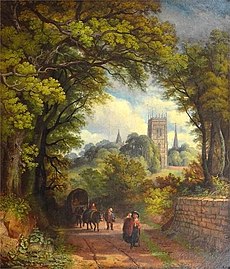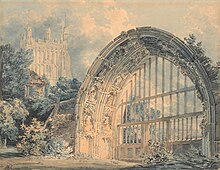
Gloucester Cathedral, formally the Cathedral Church of St Peter and the Holy and Indivisible Trinity, in Gloucester, England, stands in the north of the city near the River Severn. It originated with the establishment of a minster, Gloucester Abbey, dedicated to Saint Peter and founded by Osric, King of the Hwicce, in around 679. The subsequent history of the church is complex; Osric's foundation came under the control of the Benedictine Order at the beginning of the 11th century and in around 1058, Ealdred, Bishop of Worcester, established a new abbey "a little further from the place where it had stood". The abbey appears not to have been an initial success, by 1072, the number of attendant monks had reduced to two. The present building was begun by Abbott Serlo in about 1089, following a major fire the previous year.

Ramsey Abbey was a Benedictine abbey in Ramsey, Huntingdonshire, England. It was founded about AD 969 and dissolved in 1539.

Evesham is a market town and parish in the Wychavon district of Worcestershire, in the West Midlands region of England. It is located roughly equidistant between Worcester, Cheltenham and Stratford-upon-Avon. It lies within the Vale of Evesham, an area comprising the flood plain of the River Avon, which has been renowned for market gardening. The town centre, situated within a meander of the river, is subjected regularly to flooding. The 2007 floods were the most severe in recorded history.
Wigstan, also known as Saint Wystan, was the son of Wigmund of Mercia and Ælfflæd, daughter of King Ceolwulf I of Mercia.

An almonry is the place or chamber where alms were distributed to the poor in churches or other ecclesiastical buildings. The person designated to oversee the distribution was called an almoner.

Oswald of Worcester was Archbishop of York from 972 to his death in 992. He was of Danish ancestry, but brought up by his uncle, Oda, who sent him to France to the abbey of Fleury to become a monk. After a number of years at Fleury, Oswald returned to England at the request of his uncle, who died before Oswald returned. With his uncle's death, Oswald needed a patron and turned to another kinsman, Oskytel, who had recently become Archbishop of York. His activity for Oskytel attracted the notice of Archbishop Dunstan who had Oswald consecrated as Bishop of Worcester in 961. In 972, Oswald was promoted to the see of York, although he continued to hold Worcester also.

Sambourne, formerly spelled Sambourn, is a village and civil parish 1.5 miles (2.4 km) north-west of Coughton, 4.5 miles (7.2 km) south of Redditch, 12 miles (19 km) north-west of Stratford-upon-Avon and 20 miles (32 km) west of Warwick in the county of Warwickshire, England. It is situated on sloping ground rising westwards to about 500 feet near the ancient Ridge Way, and forms part of the county boundary with Worcestershire. The village itself is centred round a small triangular green at the junction of four roads and contains several timber-framed buildings of 17th century date. By a designation of 22 July 1991 much of the central area became a conservation area.

Ombersley is a village and civil parish in Wychavon district, in the county of Worcestershire, England. The parish includes the hamlet of Holt Fleet, where Telford's 1828 Holt Fleet Bridge crosses the River Severn. The 2011 census recorded a population of 2,360 for the parish.
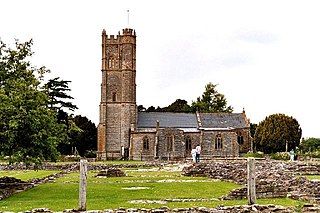
Muchelney Abbey is an English Heritage property in the village of Muchelney in the Somerset Levels, England. The site consists of ruined walls showing the layout of the abbey buildings constructed from the 7th to 16th centuries, and the remaining intact Abbot's House. It is next to the parish church in which some of the fabric of the abbey has been reused.
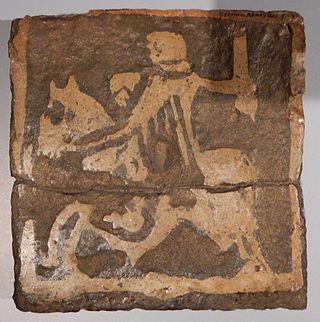
Eynsham Abbey was a Benedictine monastery in Eynsham, Oxfordshire, in England between 1005 and 1538. King Æthelred allowed Æthelmær the Stout to found the abbey in 1005. There is some evidence that the abbey was built on the site of an earlier minster, probably founded in the 7th or 8th centuries. The site is a Scheduled Historic Monument.
Æthelwig was an Abbot of Evesham before and during the Norman Conquest of England. Born sometime around 1010 or 1015, he was elected abbot in 1058. Known for his legal expertise, he administered estates for Ealdred, the Bishop of Worcester prior to his election as abbot. After his election, he appears to have acted as Ealdred's deputy, and was considered as a possible successor when Ealdred was elected Archbishop of York. Æthelwig worked during his abbacy to recover estates that had been lost to Evesham, as well as acquiring more estates.
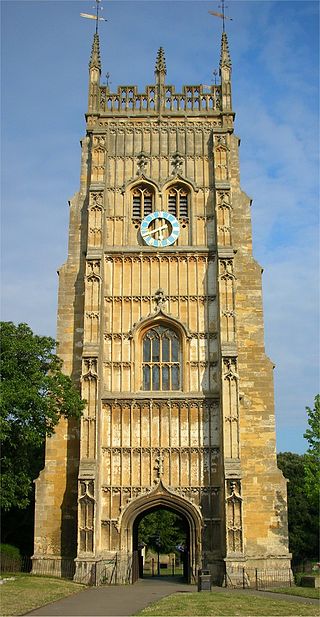
Dominic of Evesham was a medieval prior of Evesham Abbey in England and writer of religious texts. Probably a native Englishman, there is some confusion about when he became a monk, but by 1104 he was at Evesham and by 1125 he held the office of prior. He is chiefly known for his religious works, including one on the miracles of the Virgin Mary that was an important source for later writings on the subject. Four of his works are still extant.
The Abbot of Evesham was the head of Evesham Abbey, a Benedictine monastery in Worcestershire founded in the Anglo-Saxon era of English history. The succession continued until the dissolution of the monastery in 1540.

Saint Credan of Evesham is a saint in the calendar of the Roman Catholic Church and of the Eastern Orthodox Church. He is also known in Latin as Credus or Credanus.
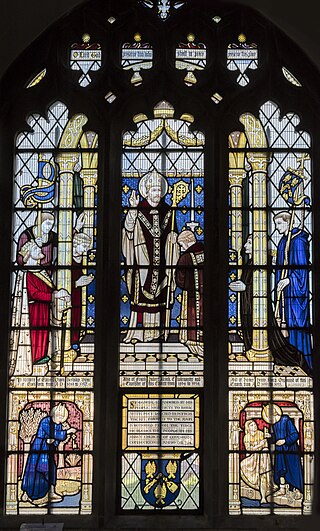
Egwin of Evesham was a Benedictine monk and, later, the third Bishop of Worcester in England. He is venerated as a saint in the Catholic Church.

St Lawrence's Church is a redundant Anglican church in the centre of the town of Evesham, Worcestershire, England. It is recorded in the National Heritage List for England as a designated Grade II* listed building, and is under the care of the Churches Conservation Trust. It stands close to All Saints Church, and to the bell tower of the former Evesham Abbey.

The Abbey Church of Saint Peter and Saint Paul, Monkwearmouth–Jarrow, known simply as Monkwearmouth–Jarrow Abbey, was a Benedictine double monastery in the Kingdom of Northumbria, England.
Roger Norreis was Abbot of Evesham in England. He was a controversial figure, installed in several offices against opposition. In his appointment to Evesham, he was accused of immoral behaviour and failing to follow monastic rules. In 1202, Norreis became embroiled in a dispute with his monks and his episcopal superior the Bishop of Worcester; litigation and argumentation lasted until his deposition in 1213. He was then appointed prior of a subsidiary monastic house of Evesham, but was deposed within months, then re-appointed to the office five years later.

Odwulf of Evesham was a ninth century saint, monk and Frisian missionary.

The Almonry Museum and Tourist Information Centre is a museum in Evesham in Worcestershire, England. It is also referred to as The Almonry Museum and just The Almonry. It is governed by Evesham Town Council. The focus of the museum is on the history of the town and Vale of Evesham. The museum derives its name from the original use of the building as the almonry of the 14th-century Evesham Abbey The museum opened within this building in 1957.

